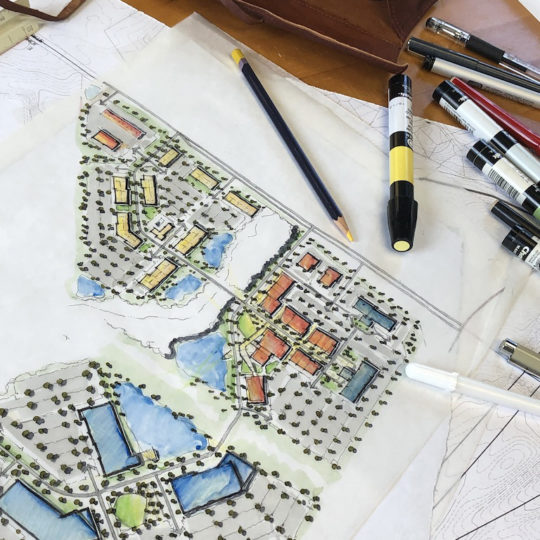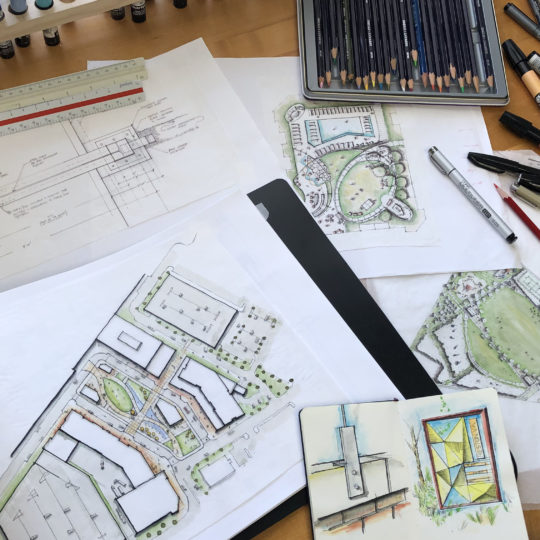by Cassidy Michaux, Director of Design
You can dazzle me with your 3D models, your photorealistic renderings and your virtual realities, but I am a firm believer that every good design begins with a messy, dirty hand drawn line. There is nothing that compares to the creative connection between your brain and a pen. Here are 4 reasons why I believe everyone should be starting their designs with a pen and a piece of paper.
1. That uninhibited brain to hand connection.
There is something empowering about grabbing a pen (or your tool of choice) and staring at a blank canvas. Without the constraints of mouse clicks and computer programs you are free to create with limitless possibilities. This freedom is an intimidating but essential part of the creative process. I am a firm believer in the fat-to-fine design process – start with the fattest pen and work to the finest. I begin with an unsecured roll of trace and my fattest pen (Pentel Sign pens are great) and crank through ideas. At this early stage, I am creating gestures and movements with the pen as an extension of my arm. As these (very messy) lines begin to come into focus, I allow myself to grab more detailed pens to bring an idea to life.
2. You can draw, draw, draw and draw again.
One of the hardest things for me to get over as I began my career was attachment to my designs and drawings. They took me a long time to create, model, illustrate and by the time I presented an idea I was invested. This approach, especially early in the design, kills the iterative process necessary to come up with the most creative, innovative and effective design solutions. As I focused on developing skills in my hand graphics toolbox, I began to notice that I could flesh out an idea very quickly.
Check out the instagram clip to see an example of how I develop a concept design.
This freedom to create and convey multiple ideas quickly allows me to receive meaningful feedback from my team and clients early in the design process. We figure the big important things out before jumping into the digital world.
3. Clearly and compellingly convey your ideas.
If you can quickly develop an idea to the point where a client or your team can react, you will win. This is a skill that takes time to develop and refine, but is extremely valuable in design charrettes or other team meetings where quick feedback and direction are critical to the design. If you can make them look pretty, even better. This leads me to my next point.
4. Hand graphics are a differentiator.
When something is drawn or created by hand it conveys a quality that cannot be replicated digitally…yet. There is something fascinating, warm and fuzzy about how the ink bleeds through the page and your colors blend and mix together that evokes an almost emotional reaction. In a business where getting a reaction is key to our success, this is an invaluable tool in the process.
Hand graphics are also unique to the designer. In an era of design where digital tools have leveled the playing field (everyone’s sketchup model of a house can be exactly the same), your hand graphics are a differentiator. They are also a skill that can be learned, look at me – case and point! The only way to learn is to practice! I’ll leave you with two pieces of advice.
- Draw something every. single. day.
- Be comfortable with your drawings looking terrible. They will. For a while.





